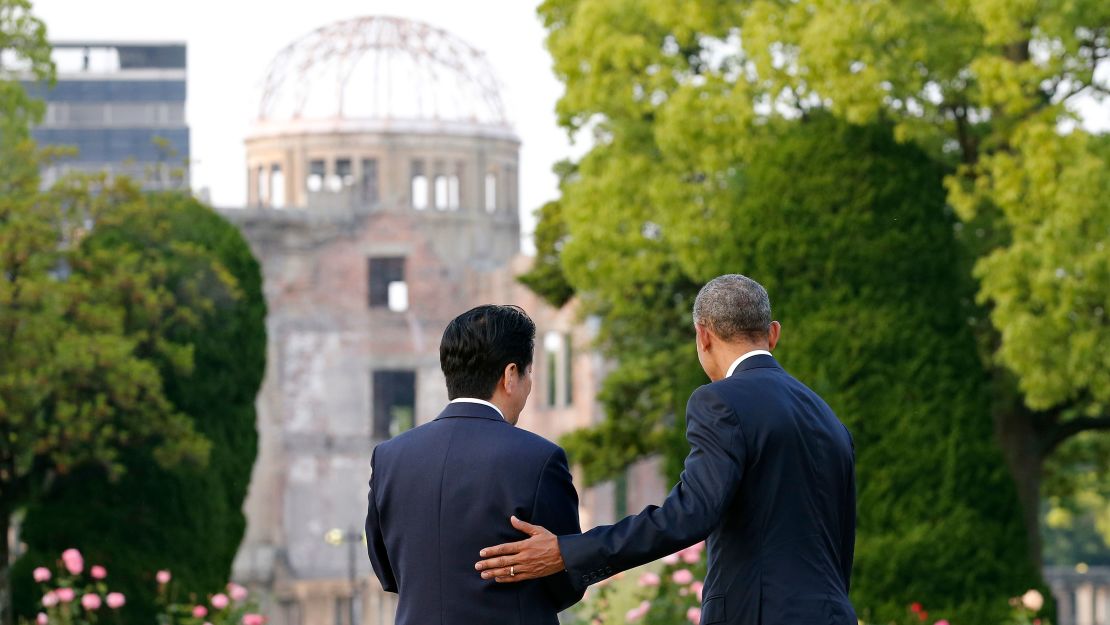It’s probably the most famous weapon in the history of war – the atomic bomb that was dropped over Hiroshima, Japan, from an American B-29 bomber on August 6, 1945.
The explosion from the bomb, named “Little Boy,” obliterated nearly everything within 10-square kilometers (nearly four square miles) in downtown Hiroshima, killing around 80,000 people. Radiation poisoning eventually sickened others, resulting in an estimated final death toll of 192,000 souls.
The bombing helped bring World War II to a quicker end and ushered in the tense Cold War in second half of the 20th century. Today, the area where horror was unleashed is a destination for healing.
A focal point of that is the Hiroshima Peace Memorial Museum. It sits across the Motoyasu River from the famous Atomic Bomb Genbaku Dome, which withstood a direct blast from the bomb.
The museum is elevated on a series of columns that overlooks greenery in every direction where there was once ruin and desolation.
Designed by Kenzō Tange and inaugurated in 1955, the museum is now a national and international symbol for peace.
What you’ll find at the museum
Evocative exhibits at the museum include a blistered and fused tricycle that a 4-year-old boy was riding during the blast that burned him to death. Similar moments are invoked through artifacts as small as a wristwatch or a lunch box carried by a student who perished at school.
These give a sense of the “pain and suffering of the victims and their bereaved families,” Rie Nakanishi of the museum’s Curatorial Division tells CNN.
Photos, documentary films, nightmarish drawings by survivors, scientific explanations of the explosion and artifacts such as melted glass and charred clothing hint at the unimaginable.
“This museum was established by the city of Hiroshima to convey the reality of the atomic bombing to the world, and contribute to the total abolition of nuclear weapons, and realization of lasting world peace,” Kenji Shiga, director of the museum, told CNN in 2015.

In May 2016, US President Barack Obama visited the museum, using the occasion to call for a “world without nuclear weapons.”
The museum is where visitors and survivors alike come together to learn more about attack and reflect on its consequences and humanity’s future. It has attracted millions of visitors to the city and has consistently been the top rated museum in Hiroshima by TripAdvisor.
Room for survivors
Many visitors say the testimony of bomb survivors (known as hibakusha) helped them humanize history. The hibakusha have been important players in Hiroshima’s peace-centric identity since the immediate aftermath of the bombing and an important part of the museum.
“The hibakusha took their anger and suffering, and rather than becoming embittered, they led the fight for nuclear abolition and opposition to war,” Peter Kuznick, director of the Nuclear Studies Institute at American University, told CNN in 2015.
“They committed themselves to turning Hiroshima into a city that was going to bear witness to the need for eliminating nuclear weapons.”
Though the number of surviving hibakusha is dwindling, the city is making a concerted effort to document their stories on paper and film. In one of the museum’s special exhibits, survivors’ drawings are captured for posterity, depicting the memories that individuals across Japan still hold of the day that changed their country forever.
“Japan is the only place where there is a really vivid example of what the nuclear age means,” said Bruce Blair, the president of Global Zero, an international organization dedicated to the elimination of nuclear weapons.
Blair said that the emotional resonance of survivor stories can galvanize people to take a more active interest in nuclear issues.
Beyond the museum
In addition to the museum, there are numerous other bombing-related places to visit in the immediate area. They include:
– Atomic Bomb Genbaku Dome. The now-iconic structure, designed in 1915 by Czech architect Jan Letzel, was the city’s Industrial Promotion Hall.
When the United States dropped the bomb, it exploded just above the building but didn’t destroy it because the immediate blast and heat buffered the air at ground zero. It became a UNESCO World Heritage Site in 1996.
– Cenotaph for Atomic Bomb Victims. Inscribed inside the central stone vault are the names of all those who were killed. When new victims are discovered, they are added to the cenotaph.
– Flame of Peace. It was lit in 1964, and the Japanese vow to keep it burning until all nuclear weapons worldwide are dismantled.
Other sites in the vicinity include the Peace Bell, Children’s Peace Monument and the Aioi Bridge, which connects the Peace Memorial Museum and Atomic Bomb Dome.
Why Hiroshima is a popular place to visit
Hiroshima is still a popular destination in Japan. Americans comprise the largest number of foreign visitors, followed by Australians and Chinese, according to local government statistics for the city and surrounding prefecture.
Countless Japanese also visit.
“The name ‘Hiroshima’ has been well-known among foreign countries from its history, and recently word-of-mouth effect from visitors adds more reality to it,” Hiroshima Convention and Visitors Bureau representative Taeko Abe told CNN. “In recent years, word-of-mouth information from the Internet also has a strong influence.”
A number of factors lay behind the city’s continuing hold on travelers.
Some describe Hiroshima as a gripping, educational and emotional example of “dark tourism,” “grief tourism” or “battlefield tourism,” which includes Nazi concentration camps in Europe, Cambodia’s torture prisons and killing fields and West African slave ports, as well as the Nagasaki Peace Park and Atomic Bomb Museum, which commemorates the second atomic bomb drop on Japan three days after Hiroshima.
Hiroshima Peace Memorial Museum, 1-2 Nakajimacho, Naka Ward, Hiroshima, 730-0811, Japan. +81 82-241-4004.
CNN’s Isabela Espadas Barros Leal and Forrest Brown contributed to this story.






